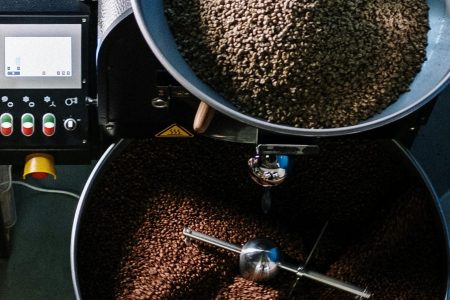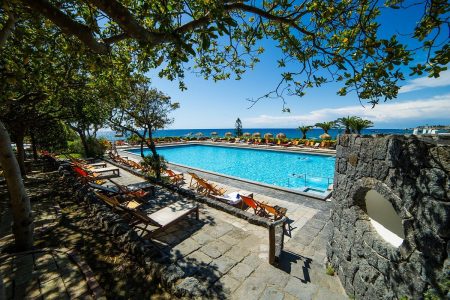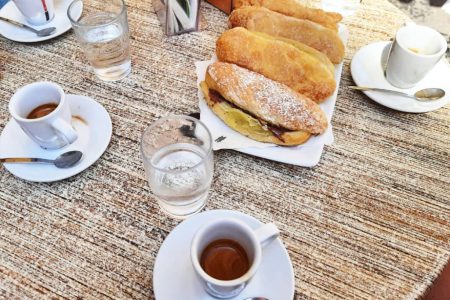In Naples the Easter like all so-called holy days (i.e., the feast days of Christianity), is a riot of traditions and gluttony where the solemnity of the sacrament and the cheerfulness of spring temperatures, are celebrated with the family, gathered around the set table. Sometimes one is away from one's family or at any rate cannot celebrate all together, but it will be enough to go back in time and remember this holiday as it was as a child. Let's see together how the Neapolitan Easter is celebrated.
Holy Week
Immediately after the long Lent which begins on the first Sunday after Shrove Tuesday and ends on Maundy Thursday, we enter the Holy Week. As children, this period also coincides with the beginning of the "Easter vacations," the short period of vacation from school. As adults, on the other hand, we think about how best to prepare to celebrate Easter Sunday.
On Maundy Thursday, we celebrate, according to Catholic belief, theLast Supper of Jesus. After Mass, however, we gather at home and celebrate with a traditional Neapolitan dish: la mussel soup.
Good Friday and Holy Saturday, on the other hand, are supposed to be fasting days (which, of course, are almost never observed). We go shopping to buy all the products that cooked properly, make all five senses celebrate.
Fresh vegetables and the most appetizing cured meats are procured so that family recipes can be brought to the table, and there is a focus on preparing pastries and casatielli. Each family has its own traditions, but in general, the Easter menu includes specific courses.
However, one should not forget to also devote time to theEaster egg. No matter if you are young or old, the chocolate egg is enjoyed by all ages.
There are all kinds of them on the market today: the classics, the artisanal and those stuffed in the most original ways. It is therefore necessary to choose the right one because everyone has his own tastes his own preferences.
The Easter egg is then unwrapped on Easter Sunday morning, with great anticipation from the little ones who will compete to be the fastest to retrieve the surprise hidden inside.
Easter at the table
This brings us to Easter Sunday lunch when we finally sit down at the table and begin to enjoy all the delicacies prepared by the women (if necessary, also by the more modern men) of the family.
The appetizer to start
The typical appetizer for this holiday is a dish full of sliced cold cuts. We are talking about the fellata napoletana. Actually, it is not just one appetizer but a combination of products including prosciutto, salami, capocollo, soppressata and other country cured meats, accompanied by cheeses, eggs and the ever-present ricotta salata. All washed down with plenty of red wine that keeps the guests' spirits high.
The Neapolitan Casatiello
We then move on to the king of the table: the Casatiello. It can be either sweet, also called Easter cone, than savory, a cross between pizza and bread with the characteristic eggs on top, not to be confused with the Tortano, where instead they are used to stuff the inside. We tell you more about this in our article.
The soup maritata
The first dish of Easter Sunday revives an ancient dish of the Neapolitan people. A poor but absolutely special soup, which constituted for the Neapolitans, their main serving dish: the minestrone soup.
Its name, which means "married" soup, stands to indicate that in this soup it is composed yes of vegetables but also of meat and cheese, in a balance that makes even those who do not have mustaches lick their whiskers!
Let's prepare maritata soup together
Maritata soup ingredients for 5 people, about 2 kg of soup
- Chicory
- Escarole
- Borage
You can also add
- Swiss chard
- Torzelle
- Broccoletti
- 1 Savoy cabbage
For the broth, on the other hand, we need
- 1 carrot
- 1 large onion
- 1 celery rib
- 1 tuft of parsley
- 6 liters of water
- 1 hen of about 1 kg (preferably already cleaned)
- 300 g of sausages and 1 kg of beef
- Salt and grated cheese to taste.
Making traditional minestra maritata takes time, patience and love. Let's start with the broth. In a large pot place the cleaned vegetables, chicken and cubed beef. After bringing it to a boil, adjust the heat to low and let the broth cook for about 5 hours. From time to time, with the help of a skimmer, degrease the broth. If you want to speed up the time, cook it in a pressure cooker for an hour.
Meanwhile, clean the vegetables and cook them in a pot with salt.
When the broth is ready, set aside the meat, debone the chicken, and cut the sausages into rounds.
Combine everything in a very large pot and let it heat up. Meanwhile, add the grated cheese, which will become stringy with heat.
Roasted artichokes
There is no simpler and more appreciated delicacy, than the roasted artichoke. A Neapolitan Easter tradition but also a Sunday treat, the "carcioffola arrustuta" is the highlight of holiday lunches. In the villages or at any rate in the suburbs of Naples, it is not difficult to come across steaming banquettes on the side of the road from which the inviting aroma of artichokes cooked directly on the charcoal embers emanates. If you have a charcoal grill and some charcoal (and of course the appropriate space to cook), it will not be difficult to prepare this delicacy. Be careful though, the roasted artichokes must categorically be of Neapolitan quality, i.e. the violet artichoke of Castellammare.
Let's prepare Castellammare Artichoke together.
To prepare the artichokes before roasting them over the coals, excess water must be removed. With your fingers, space out the central leaves by spreading them to create a space where you can place a piece of garlic, some parsley leaves and salt to taste.
On the coals they should cook from thirty minutes to an hour. When they are apparently charred and the central leaves quite shriveled and dark green in color, then they are ready. Discard the outermost leaves and serve.
Easter lamb
Tradition dictates that at Easter we eat thelamb. A tradition that has very ancient origins, from Passover. Today this custom is gradually disappearing partly because some people do not like to think of poor baby lambs being sacrificed to make a dish. Days before the Passover season, animal rights campaigns against the killing of these puppies are read almost everywhere. So to prepare the second course of the Easter menu, some people replace this meat with that of chicken, turkey or pork.
More traditionalist families, on the other hand, prepare pan-fried lamb with peas on this feast day. However, there are those who prefer to cook it roasted with potatoes, resorting to the use of the oven.
Let's prepare lamb with peas together.
To prepare lamb with peas you will need the following.
- 1 kg of meat
- 1 large onion
- 200 g shelled peas (also frozen ones but still recommend that they be fine or very fine)
- Salt and pepper to taste.
- A small glass (about 200 ml) of white wine
In a skillet, sauté the onion in a little oil. Once browned, add the shredded meat and brown it. When browned, season with salt and pepper and deglaze with white wine. Cover and let it cook over a low flame until the meat appears quite cooked and the wine has almost completely evaporated. At this point add the peas and when they too are cooked, adjust the salt and pepper if necessary.
Easter beans in Naples: those of Vesuvius.
In between dishes or while waiting for dessert, on the tables of Neapolitans on Easter Sunday, there can be no shortage of the broad beans. A typical product of this land, Neapolitan broad beans sprout right in Spring, between March and April. They are mostly grown in the Vesuvian towns and have a truly distinctive flavor. The excellent quality of this product of excellence, derives in fact from the very place where they are grown: on volcanic soil rich in minerals and with temperatures mitigated by the proximity of the sea.
The Neapolitan pastiera
Finally, we come to the much-anticipated dessert typical of Easter in Naples: the pastiera napoletana. This dessert is very special and has very ancient origins. Legends and stories hover about it, which together with its floral and fresh taste, make it truly exceptional.
There are many versions of it, so much so that we had to devote even to the preparation of the pastiera a article separately. Everyone prepares it following the family recipe. In any case, this is the best way to end the Easter meal.
The Pasquetta
In Naples, celebrations continue even after Easter Sunday. On Easter Monday, that is the Easter, is the day dedicated to picnics and the classic outing to enjoy the mild spring temperatures. On an outing it is customary to bring a packed lunch with what is left over from the lavish meal of the day before, especially if it is Casatiello.
Should this not be possible, then all that is left to do is to sit back down at the table and continue to be enchanted by the tasty Easter dishes and perhaps even enjoy the Colomba, a cake invented in Milan in the 1930s.








0 Comments